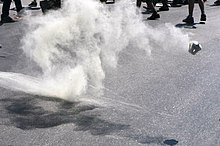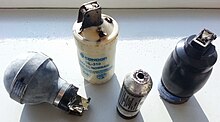-
(시사) 최루탄에 대하여사람되기/시사 2015. 4. 26. 00:50
Source: http://en.wikipedia.org/wiki/Tear_gas
Tear gas 최루탄
From Wikipedia, the free encyclopediaTear gas, formally known as a lachrymatory agent or lachrymator (from lacrima meaning "tear" in Latin), is a chemical weapon that stimulates the corneal nerves in the eyes to cause tears, pain, vomiting, and even blindness. Common lachrymators include pepper spray (OC gas), CS gas, CR gas, CN gas (phenacyl chloride), nonivamide, bromoacetone, xylyl bromide, syn-propanethial-S-oxide (from onions), and Mace (a branded mixture). 최루탄은 본래 lachrymatory agent 혹은 lachrymator로 알려진 것으로, 일종의 화학무기이며, 눈에 있는 각막신경을 자극하여 눈물을 흘리게 하거나 통증을 유발하며 구토를 유발하며 심지어는 실명을 초래한다. 일반적인 lachrymators에는 고추스프레이(OC가스), CS가스, CR가스, CN가스, 노니다미드, 브로모아세토네, 시릴 브로미드,신-프로파네티알-에-옥시드, 그리고 메이스가 포함되어 있다.
Lachrymatory agents are commonly used for riot control. Their use as chemical warfare agents is prohibited by various international treaties. During World War I, increasingly toxic lachrymatory agents were used.
Effects[edit]
Tear gas works by irritating mucous membranes in the eyes, nose, mouth and lungs, and causes crying, sneezing, coughing, difficulty breathing, pain in the eyes, and temporary blindness. With CS gas, symptoms of irritation typically appear after 20–60 seconds of exposure[1] and commonly resolve within 30 minutes of leaving (or being removed from) the area.[2] With pepper spray (also called "oleoresin capsicum", capsaicinoid or OC gas), the onset of symptoms, including loss of motor control, is almost immediate.[2] There can be considerable variation in tolerance and response, according to the National Research Council (US) Committee on Toxicology.[3]
The California Poison Control System analyzed 3,671 reports of pepper spray injuries between 2002 and 2011.[4] Severe symptoms requiring medical evaluation were found in 6.8% of people, with the most severe injuries to the eyes (54%), respiratory system (32%) and skin (18%). The most severe injuries occurred in law enforcement training, intentionally incapacitating people, and law enforcement (whether of individuals or crowd control).[4]
Lachrymators are thought to act by attacking sulfhydryl functional groups in enzymes. one of the most probable protein targets is theTRPA1 ion channel that is expressed in sensory nerves (trigeminal nerve) of the eyes, nose, mouth and lungs.
Risks[edit]
As with all non-lethal, or less-than-lethal weapons, there is some risk of serious permanent injury or death when tear gas is used.[5][6]This includes risks from being hit by tear gas cartridges, which include severe bruising, loss of eyesight, skull fracture, and even death.[7]A case of serious vascular injury from tear gas shells has also been reported from Iran, with high rates of associated nerve injury (44%) and amputation (17%),[8] as well as instances of head injuries in young people.[9]
While the medical consequences of the gases themselves are typically limited to minor skin inflammation, delayed complications are also possible: people with pre-existingrespiratory conditions such as asthma, who are particularly at risk, are likely to need medical attention[1] and may sometimes require hospitalization or even ventilation support.[10] Skin exposure to CS may cause chemical burns[11] or induce allergic contact dermatitis.[1][2] When people are hit at close range or are severely exposed, eye injuries involving scarring of the cornea can lead to a permanent loss in visual acuity.[12]
Use[edit]
Warfare[edit]
Use of tear gas in warfare (as all other chemical weapons) is prohibited by various international treaties[13] that most states have signed. Police and private self-defense use is not banned in the same manner. Armed forces can legally use tear gas for drills (practicing with gas masks) and for riot control. First used in 1914, xylyl bromide was a popular tearing agent since it was easily brewed.
The US Chemical Warfare Service developed tear gas grenades for use in riot control in 1919.[14]
Riot control[edit]
Certain lachrymatory agents are often used by police to force compliance, most notably tear gas.[6] In some countries (e.g., Finland, Australia, and the United States), another common substance is mace. The self-defense weapon form of mace is based on pepper spray, and comes in small spray cans, and versions including CS are manufactured for police use.[15] Xylyl bromide, CN and CS are the oldest of these agents, and CS is the most widely used. CN has the most recorded toxicity.[1]
Typical manufacturer warnings on tear gas cartridges state "Danger: Do not fire directly at person(s). Severe injury or death may result."[16] Such warnings are not necessarily respected, and in some countries, disrespecting these warnings is routine. In the 2013 protests in Turkey, there were hundreds of injuries among protesters targeted with tear gas projectiles.[citation needed] In the Israeli-occupied territories, Israeli soldiers have been routinely documented by Israeli human rights group in firing direct tear gas canisters at activists, some of which resulted in fatalities.[17][18]
However, tear gas guns do not have a manual setting to adjust the range of fire. The only way to adjust the projectile's range is to aim towards the ground at the correct angle. Incorrect aim will send the capsules away from the targets, causing risk for non-targets instead.[19] For example, this occurred during the 2013 protests in Brazil and 2014 Hong Kong Protests.
Counter-measures[edit]
A variety of protective equipment may be used, including gas masks and respirators. In riot control situations, protesters sometimes use equipment (aside from simple rags or clothing over the mouth) such as swimming goggles and adapted water bottles.[20]
Treatment[edit]
There is no effective antidote to common tear gases.[1] Getting clear of gas and into fresh air is the first line of action.[1] Once a person has been exposed, there is a variety of methods to remove as much chemical possible and relieve symptoms.[1] The standard first aid for burning solutions in the eye is irrigation (spraying or flushing out) with water,[1][21] and some evidence suggests that diphoterine[22]solution, a first aid product for chemical sprays, may help with ocular burns or chemicals in the eye.[21][23]
Home remedies[edit]
Activists in the United States, the Czech Republic, Venezuela and Turkey have reported using antacid solutions such as Maalox diluted with water as a home remedy for tear gas attacks.[24][25][26] Vinegar, vaseline, milk and lemon juice solutions have also been used by activists.[27][28][29][30] It is unclear how effective these remedies are. In particular, vinegar itself can burn the eyes and prolonged inhalation can also irritate the airways.[31]
See also[edit]
References[edit]
- ^ a b c d e f g h Schep, LJ; Slaughter, RJ; McBride, DI (Dec 30, 2013). "Riot control agents: the tear gases CN, CS and OC--a medical review.". Journal of the Royal Army Medical Corps. doi:10.1136/jramc-2013-000165. PMID 24379300.
- ^ a b c Smith, J; Greaves, I (March 2002). "The use of chemical incapacitant sprays: a review" (PDF). J Trauma 52 (3): 595–600. doi:10.1097/00005373-200203000-00036.PMID 11901348. Retrieved 24 June 2013.
- ^ National Research Council (US) Committee on Acute Exposure Guideline, Levels; National Research Council (US) Committee on, Toxicology (2011). PMID 24983066.Missing or empty
|title=(help) - ^ a b Kearney, T; Hiatt, P; Birdsall, E; Smollin, C (Jul–Sep 2014). "Pepper spray injury severity: ten-year case experience of a poison control system.". Prehospital emergency care : official journal of the National Association of EMS Physicians and the National Association of State EMS Directors 18 (3): 381–6. doi:10.3109/10903127.2014.891063.PMID 24669935.
- ^ Heinrich U (September 2000). "Possible lethal effects of CS tear gas on Branch Davidians during the FBI raid on the Mount Carmel compound near Waco, Texas"(PDF). Prepared for The Office of Special Counsel John C. Danforth.
- ^ a b Hu H, Fine J, Epstein P, Kelsey K, Reynolds P, Walker B (August 1989). "Tear gas--harassing agent or toxic chemical weapon?" (PDF). JAMA 262 (5): 660–3.doi:10.1001/jama.1989.03430050076030. PMID 2501523.
- ^ Clarot F, Vaz E, Papin F, Clin B, Vicomte C, Proust B (October 2003). "Lethal head injury due to tear-gas cartridge gunshots". Forensic Sci. Int. 137 (1): 45–51. doi:10.1016/S0379-0738(03)00282-2. PMID 14550613.
- ^ Wani, ML; Ahangar, AG; Lone, GN; Singh, S; Dar, AM; Bhat, MA; Ashraf, HZ; Irshad, I (Mar 2011). "Vascular injuries caused by tear gas shells: surgical challenge and outcome.". Iranian journal of medical sciences 36 (1): 14–7. PMID 23365472.
- ^ Wani, AA; Zargar, J; Ramzan, AU; Malik, NK; Qayoom, A; Kirmani, AR; Nizami, FA; Wani, MA (2010). "Head injury caused by tear gas cartridge in teenage population.". Pediatric neurosurgery 46 (1): 25–8. doi:10.1159/000314054. PMID 20453560.
- ^ Carron, PN; Yersin, B (19 June 2009). "Management of the effects of exposure to tear gas". BMJ 338: b2283. doi:10.1136/bmj.b2283. PMID 19542106.
- ^ Worthington E, Nee PA (May 1999). "CS exposure—clinical effects and management". J Accid Emerg Med 16 (3): 168–70. doi:10.1136/emj.16.3.168.PMC 1343325. PMID 10353039.
- ^ Oksala A, Salminen L (December 1975). "Eye injuries caused by tear-gas hand weapons". Acta Ophthalmol (Copenh) 53 (6): 908–13. doi:10.1111/j.1755-3768.1975.tb00410.x. PMID 1108587.
- ^ e.g. the Geneva Protocol of 1925: 'Prohibited the use of "asphyxiating gas, or any other kind of gas, liquids, substances or similar materials"'
- ^ Jones DP (April 1978). "From Military to Civilian Technology: The Introduction of Tear Gas for Civil Riot Control". Technology and Culture 19 (2): 151–168. JSTOR 3103718.
- ^ "Mace pepper spray". Mace (manufacturer). Retrieved 21 February 2014.
- ^ Smith E (2011-01-28). "Controversial tear gas canisters made in the USA". Africa. CNN.com.
- ^ "Israeli soldiers continue firing tear gas canisters directly at human targets, despite the army’s denials". B'tselem. Retrieved 27 December 2013.
- ^ "Israeli MAG Corps closes file in Mustafa Tamimi killing, stating the tear-gas canister that killed him was fired legally". B'tselem. Retrieved 27 December 2013.
- ^ Turkish Doctors' Association, 16 June 2013, TÜRK TABİPLERİ BİRLİĞİ’NDEN ACİL ÇAĞRI !
- ^ "Gezi park protesters bring handmade masks to counter police tear-gas rampage".Hurriyet Daily News.
- ^ a b Chau JP, Lee DT, Lo SH (August 2012). "A systematic review of methods of eye irrigation for adults and children with ocular chemical burns". Worldviews Evid Based Nurs 9 (3): 129–38. doi:10.1111/j.1741-6787.2011.00220.x. PMID 21649853.
- ^ diphoterine
- ^ Viala B, Blomet J, Mathieu L, Hall AH (July 2005). "Prevention of CS 'tear gas' eye and skin effects and active decontamination with Diphoterine: preliminary studies in 5 French Gendarmes". J Emerg Med 29 (1): 5–8. doi:10.1016/j.jemermed.2005.01.002.PMID 15961000.
- ^ David Ferguson (2011-09-28). "‘Maalox’-and-water solution used as anti-tear gas remedy by protesters". Raw Story.
- ^ "Medical information from Prague 2000".
- ^ Ece Temelkuran (2013-06-03). "Istanbul is burning". Occupy Wall Street.
- ^ Agence France-Press. "Tear gas and lemon juice in the battle for Taksim Square". NDTV. Retrieved 23 June 2013.
- ^ Megan Doyle (24 June 2013). "Turks in Pittsburgh concerned for their nation".Pittsburgh Post-Gazette.
- ^ Tim Arango (15 June 2013). "Police Storm Park in Istanbul, Setting Off a Night of Chaos". New York Times.
- ^ Gareth Hughes (25 June 2013). "Denbigh man tear gassed". The Free Press.
- ^ Toxic Use Reduction Institute. "Vinegar EHS". Toxics Use Reduction Institute, UMAss Lowell. Retrieved 22 June 2013.
External links[edit]

Wikimedia Commons has media related toLachrymatory agents. - BBC information about CS gas
- How to combat CS gas at eco-action.org
- Brone et al (2008)
'사람되기 > 시사' 카테고리의 다른 글
(시사/동영상) 뉴스타파 - 울지마, 모이지마, 기억하지마(2015.4.30) (0) 2015.05.02 (시사/동영상) 뉴스타파 - 항상 박근혜는 없다(2015.4.23) (0) 2015.04.26 (시사) 경찰이 시위대에 뿌리는 캡사이신(capsaicin)은 무엇인가? (0) 2015.04.24 (시사) 다음/아고라/coma님의 글: 권선동 주장을 조목조목 반박한다! (0) 2015.04.23 (시사) 다음/아고라/바람부는언덕님의 글: 권성동 무너뜨린 정두언의 카운터 펀치 (0) 2015.04.23





